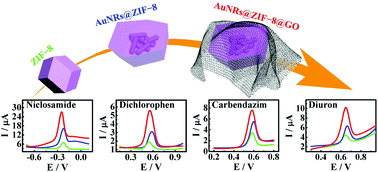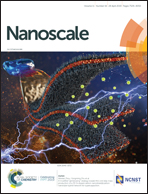Synthesis of Au nanorod-embedded and graphene oxide-wrapped microporous ZIF-8 with high electrocatalytic activity for the sensing of pesticides†
Abstract
Multifunctional metal–organic framework-based composites display great potentials as electrode materials. Herein, highly dispersed Au nanorods were successfully encapsulated inside the zeolitic imidazolate framework ZIF-8 (AuNRs@ZIF-8) by epitaxial growth or nucleus coalescence. The microporous ZIF-8 shell functions as a protective coating to effectively prevent AuNRs from dissolution, aggregation, and migration during the electrochemical testing, while it provides numerous channels for the mass transfer of reactants to the AuNR surface. The as-synthesized AuNRs@ZIF-8 was then encapsulated in graphene oxide (GO) nanosheets to enhance the chemical resistance of the multicore–shell support, which possesses permanent porosity as well as high specific surface area and hydrophilicity. The excellent electrocatalytic performance of the resulting ternary AuNRs@ZIF-8@GO was demonstrated by the highly sensitive sensing of niclosamide, dichlorophen, carbendazim, and diuron, which outperformed the reported electrocatalysts for these four pesticides. This nanocomposite thus holds great promise as a catalyst for electrochemical sensor fabrication due to its abundant multiple active sites, enhanced catalytic activity, and remarkable stability.

- This article is part of the themed collection: Nanocarbons


 Please wait while we load your content...
Please wait while we load your content...